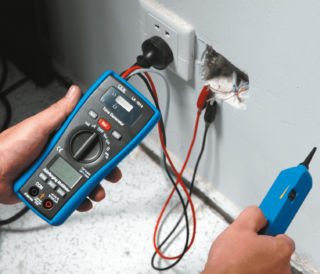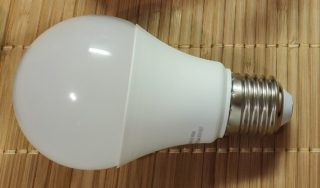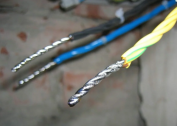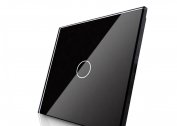Illich's bulbs are gradually being replaced by new models - energy-saving LED-lamps. Modern light bulbs are reliable, aesthetic, consume less electricity and, according to manufacturers, last about 10-12 years (about 30 thousand hours of continuous light). But sometimes users are faced with an unusual phenomenon - the flickering of LEDs without power. With classic lamps, this does not happen. To understand why the energy-saving light blinks when the light is off, you need to understand the device’s principle, requirements and rules.
How are modern energy-saving lamps
 Unlike a classic incandescent lamp, energy-saving ones produce a greater flow of light with less power consumption. Different options are available - daylight, cold, warm light, others. Installation in the apartment does not require special devices and separate tools - the connection is carried out in a standard type cartridge.
Unlike a classic incandescent lamp, energy-saving ones produce a greater flow of light with less power consumption. Different options are available - daylight, cold, warm light, others. Installation in the apartment does not require special devices and separate tools - the connection is carried out in a standard type cartridge.
Compact LED bulbs are a type of fluorescent light bulb. The device works by a simple principle, which practically does not differ in models. The lamp consists of the following parts:
- gas discharge tube - the bulb from which the glow emanates;
- case - hides the internal elements of the bulb;
- socle - the same element in comparison with incandescent lamps, the thread allows you to screw and fasten the device into the cartridge; in the middle part there is a contact that closes the circuit and conducts electricity.
The base size E27 is household, the size is classic. E40 and E14 - are suitable for the cartridges of Ilyich bulbs, are selected according to the diameter (the numbers indicate the length in millimeters).
The flask - in most cases twisted into a spiral - is sealed on both sides and attached to the body, electrodes are placed at the ends. The inner part is covered with a special substance - a phosphor. The tube is filled with inert gas and mercury vapor (the content is minimal, therefore it does not harm human health). At the moment of connection with the electric network, the gas is activated and ionized, it lights up, which is accompanied by the glow of the chemical elements of the phosphor.
Mercury is a hazardous chemical compound. In energy-saving light bulbs, the substance content is minimal, but if the device breaks, it is important to quickly and correctly remove the fragments, process and disinfect the place of impact.
The housing is made of flame retardant plastic. Important information is applied to the surface - marking indicating power, voltage, color temperature, and shutdown limits.
Why eliminate flicker
Constant flashing of the bulb interferes with use, especially in the dark. On the technical side, the lamp life is reduced (about two times). Repair begins with simple solutions and only then apply radical measures. First check the capabilities of the light bulb, then move on to electrical wiring and other, more serious issues.
Why the off energy-saving lamp blinks
The most common and frightening disadvantage of using LEDs is that the energy-saving lamp flashes when the power is off. Such "non-standard" behavior is due to three main reasons. To fix the problem, you need to understand which one is taking place.
Switch backlight
Switches and switches are often decorated with colorful lights. They use a small LED or a bulb with a neon filler, which add functionality and convenience - the mechanism is easier to find in the dark if there is additional illumination. But there was a problem with flickering - a current charge accumulates on the capacitor, which causes a reaction in the dark.
The scheme of work is as follows:
- At the moment of circuit closure, electricity is redirected to the lamp in full.
- After the contacts are disconnected, the current flows to the backlight LED, but a small part accumulates on the bulb capacitor.
- If the accumulated amount is sufficient, after switching on the fluorescent lamp starts flashing.
- The cycle can be repeated while electricity is being supplied, and the parts remain operational.
Many manufacturers write on the package that the energy-saving lamp is incompatible with illuminated switches, brightness controls, and other abnormal devices. It is believed that such add-ons create critical conditions for the operation of LEDs and quickly disable them.
Wiring Issues
Another reason is a malfunction that occurred with the wiring. In this case, the sources do not matter - outdated equipment, violation of the integrity of the wires, wiring errors. A common option is an incorrect opening of the circuit to zero, and not to phase. The connection is verified by the wizard. You can conduct the study yourself, but you will need certain knowledge and equipment for measuring voltage (a special indicator or electrical meter).
When working, it is important to consider the general condition of the wiring. Compliance with safety rules and requirements is mandatory.
Poor quality lamp
In most cases, the cause of the malfunction becomes cheap or faulty equipment - lamps, lamps, sconces, chandeliers. In an effort to save money, buyers purchase devices of dubious quality at the lowest prices. Most of these devices do not comply with current standards and state standards. When buying, take into account the following points:
- packaging integrity;
- reputation of the manufacturer and seller;
- performance check before purchase.
For residential premises choose warm calm light, non-residential - cold daylight. Compact fluorescent devices are preferred, but the final choice is made based on the specific situation.
How to eliminate the cause of blinking
If the cause of the blinking of the energy-saving light when the switch is turned off is established, you can try to fix the problem yourself. Certain tools will be required: a screwdriver, an electric current indicator, wire cutters, and shrink film.
Dismantling the backlight
Complete elimination of the cause or malfunction is a radical, but the most effective way. The first when working with any parts of the wiring is to de-energize the site and a specific point. They check the presence of voltage with a special device (voltmeter, indicator), you can turn the mechanism on and off. Then perform the following steps:
- Remove the buttons (it is better to use a thin slotted screwdriver).
- Unscrew securing parts (screws).
- Remove the device from the seat.
- On the inside, find the box and the place where the backlight is installed.
- Check the method of connecting to the power supply, disconnect, isolate the contacts.
It is important to consider the appearance of the switch - some elements are fixed from the outside, the removal of parts can ruin the design.
Change the power circuit settings
 If you can’t completely remove the backlight, you can solder a resistor of greater resistance to the wires to power the indicator and an additional diode 1n4007. The latter will allow you to cut off one half-cycle of the supply voltage.
If you can’t completely remove the backlight, you can solder a resistor of greater resistance to the wires to power the indicator and an additional diode 1n4007. The latter will allow you to cut off one half-cycle of the supply voltage.
An important nuance - such alteration requires the ability to work with a soldering iron and small parts. The area of the circuit does not allow you to “turn around”, so if there are no relevant skills, it is better to contact the wizard.
Create parallel circuit with less resistance
To maintain the backlight, but to avoid problems with blinking, you need to create a "workaround" for electricity:
- a resistor is purchased in the electrical parts store (another name is resistance) - power is 2 watts, the value of the nominal resistance is 50 thousand ohms;
- the device is connected parallel to the lamp connection - in the junction box, connect the device between phase and zero or in the housing, close to the flashing light.
In high-quality backlit switches, such additional resistors are installed immediately, so expensive devices do not blink. Chinese and less responsible manufacturers do not "bother" with additional details, so the fluorescent lights are buzzing and flickering.
Why does the lamp blink when connected correctly
If the connections to the lamp are correct and the flicker does not stop, make sure that the wiring is correct. The meaning of the circuit breaker is to connect and disconnect the phase contact. In some cases, the switch falls to zero, so a flashing effect occurs. In the junction box, you need to change the contact, in rare cases, you may need a new cable.
When the light bulb is located far from the switch and the distribution box, EMF can be induced on the wires. This effect often provokes the flickering of fluorescent lamps. At the same time, a laid cable, actively used gadgets and electrical appliances can become a source.
Independent search for the cause of the malfunction
The main rule is compliance with safety requirements. Among professional electricians, there are special training ranks - the degree depends on the amount of voltage with which the master has to work. For household maintenance of electric networks, the requirements are simpler, but there are general immutable rules:
- Full blackout of the network - you should turn off the machine at the entrance to the room.
- Exclude high humidity - it is forbidden to work if there are wet walls on the floor of the puddle.
- Use insulated tools (rubber handles, for example).
Attentiveness and caution when performing work will ensure safety, preservation of health and life. If the requirements are met, a methodical troubleshooting and repair is carried out, the lamp will stop flickering at night.
An optional, but important recommendation - when performing large-scale work, it is worth warning the neighbors about the upcoming repair. On the one hand, if an accident occurs, there will be an opportunity to quickly resolve any issue. On the other hand, relations with neighbors will become more respectful.
Before buying energy-saving lamps, it is worth clarifying the general rules and features of such devices. If the store is reliable, you can consult with the seller - describe the situation, important points. You may have to pay more than planned - this is acceptable if you purchase better equipment with additional resistors and protection drivers.







